Knowledge Assessment: CHCECE025 Embed Sustainable Practices
VerifiedAdded on 2021/04/17
|20
|4498
|435
Homework Assignment
AI Summary
This document presents a completed knowledge assessment for the CHCECE025 unit, focusing on embedding sustainable practices in early childhood service operations. It begins with definitions of sustainability principles, including ecological integrity, integrating environmental considerations, non-renewable resources, precautionary behavior, community involvement, continual improvement, equity, and democracy. The assignment then identifies relevant National Quality Standards (NQS) and outlines organizational goals for sustainability. It explores ways services can embed sustainable practices through gardening, recycling, and resource conservation, and how educators can engage children in environmental sustainability. The assessment also defines the central focus of the Sustainability Curriculum Framework and includes a plan for a hands-on learning experience for preschool children to explore lifecycles, growth, and change within the natural environment, emphasizing the interdependence between people, plants, animals, and the land. The assignment is a comprehensive overview of sustainable practices in the context of early childhood education.
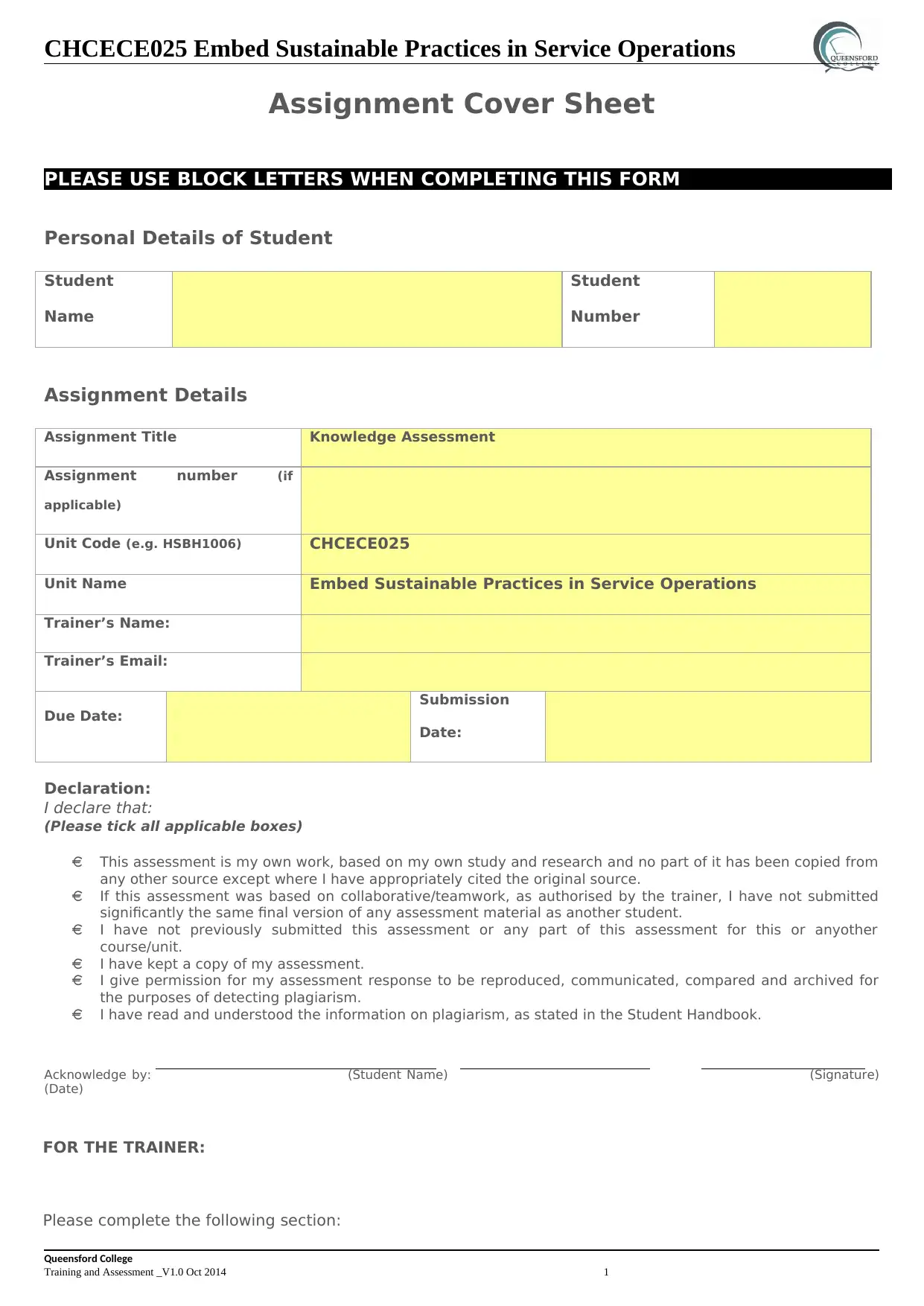
CHCECE025 Embed Sustainable Practices in Service Operations
Assignment Cover Sheet
PLEASE USE BLOCK LETTERS WHEN COMPLETING THIS FORM
Personal Details of Student
Student
Name
Student
Number
Assignment Details
Assignment Title Knowledge Assessment
Assignment number (if
applicable)
Unit Code (e.g. HSBH1006) CHCECE025
Unit Name Embed Sustainable Practices in Service Operations
Trainer’s Name:
Trainer’s Email:
Due Date:
Submission
Date:
Declaration:
I declare that:
(Please tick all applicable boxes)
This assessment is my own work, based on my own study and research and no part of it has been copied from
any other source except where I have appropriately cited the original source.
If this assessment was based on collaborative/teamwork, as authorised by the trainer, I have not submitted
significantly the same final version of any assessment material as another student.
I have not previously submitted this assessment or any part of this assessment for this or anyother
course/unit.
I have kept a copy of my assessment.
I give permission for my assessment response to be reproduced, communicated, compared and archived for
the purposes of detecting plagiarism.
I have read and understood the information on plagiarism, as stated in the Student Handbook.
Acknowledge by: (Student Name) (Signature)
(Date)
FOR THE TRAINER:
Please complete the following section:
Queensford College
Training and Assessment _V1.0 Oct 2014 1
Assignment Cover Sheet
PLEASE USE BLOCK LETTERS WHEN COMPLETING THIS FORM
Personal Details of Student
Student
Name
Student
Number
Assignment Details
Assignment Title Knowledge Assessment
Assignment number (if
applicable)
Unit Code (e.g. HSBH1006) CHCECE025
Unit Name Embed Sustainable Practices in Service Operations
Trainer’s Name:
Trainer’s Email:
Due Date:
Submission
Date:
Declaration:
I declare that:
(Please tick all applicable boxes)
This assessment is my own work, based on my own study and research and no part of it has been copied from
any other source except where I have appropriately cited the original source.
If this assessment was based on collaborative/teamwork, as authorised by the trainer, I have not submitted
significantly the same final version of any assessment material as another student.
I have not previously submitted this assessment or any part of this assessment for this or anyother
course/unit.
I have kept a copy of my assessment.
I give permission for my assessment response to be reproduced, communicated, compared and archived for
the purposes of detecting plagiarism.
I have read and understood the information on plagiarism, as stated in the Student Handbook.
Acknowledge by: (Student Name) (Signature)
(Date)
FOR THE TRAINER:
Please complete the following section:
Queensford College
Training and Assessment _V1.0 Oct 2014 1
Paraphrase This Document
Need a fresh take? Get an instant paraphrase of this document with our AI Paraphraser
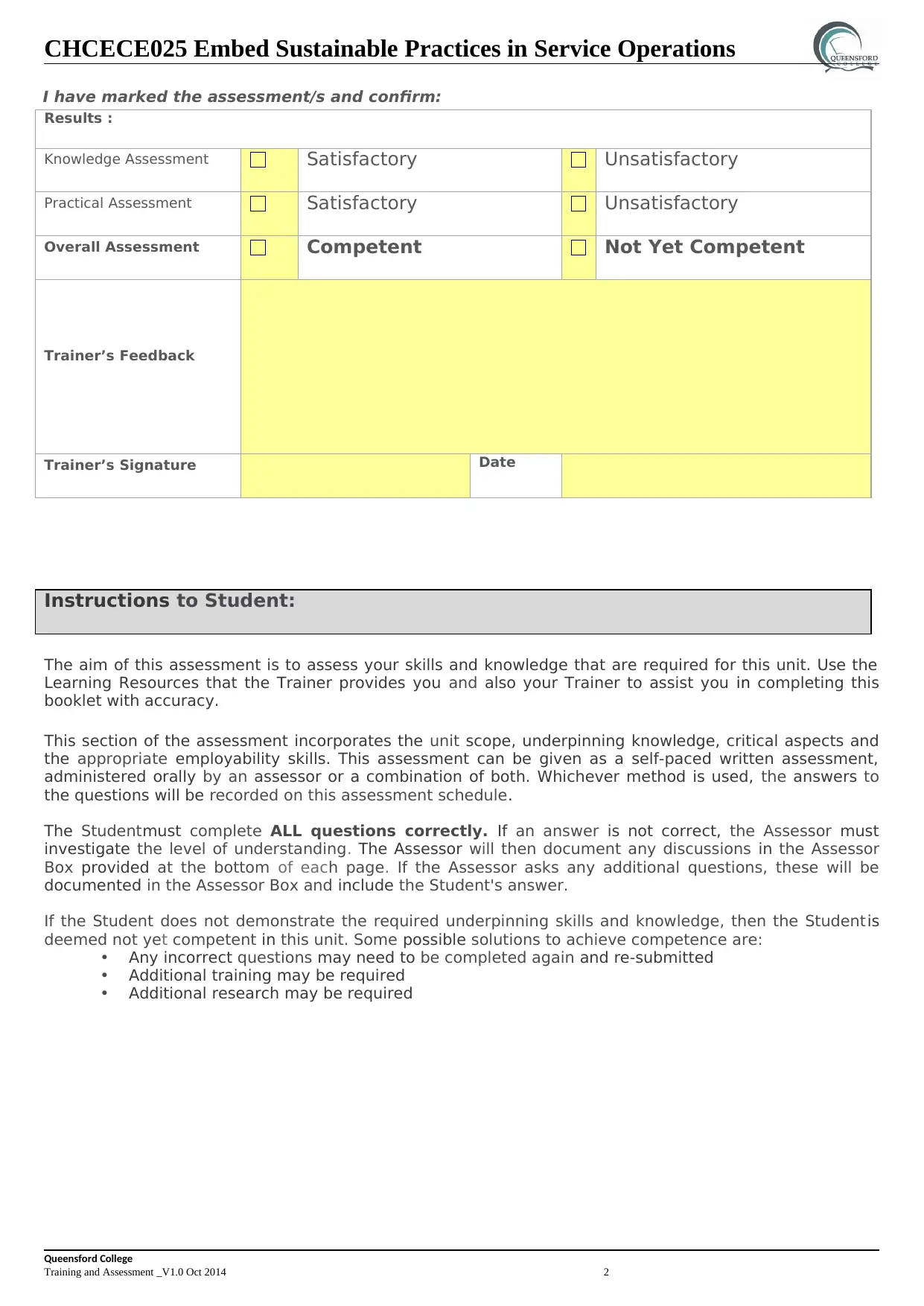
CHCECE025 Embed Sustainable Practices in Service Operations
I have marked the assessment/s and confirm:
Results :
Knowledge Assessment Satisfactory Unsatisfactory
Practical Assessment Satisfactory Unsatisfactory
Overall Assessment Competent Not Yet Competent
Trainer’s Feedback
Trainer’s Signature Date
Instructions to Student:
The aim of this assessment is to assess your skills and knowledge that are required for this unit. Use the
Learning Resources that the Trainer provides you and also your Trainer to assist you in completing this
booklet with accuracy.
This section of the assessment incorporates the unit scope, underpinning knowledge, critical aspects and
the appropriate employability skills. This assessment can be given as a self-paced written assessment,
administered orally by an assessor or a combination of both. Whichever method is used, the answers to
the questions will be recorded on this assessment schedule.
The Studentmust complete ALL questions correctly. If an answer is not correct, the Assessor must
investigate the level of understanding. The Assessor will then document any discussions in the Assessor
Box provided at the bottom of each page. If the Assessor asks any additional questions, these will be
documented in the Assessor Box and include the Student's answer.
If the Student does not demonstrate the required underpinning skills and knowledge, then the Studentis
deemed not yet competent in this unit. Some possible solutions to achieve competence are:
• Any incorrect questions may need to be completed again and re-submitted
• Additional training may be required
• Additional research may be required
Queensford College
Training and Assessment _V1.0 Oct 2014 2
I have marked the assessment/s and confirm:
Results :
Knowledge Assessment Satisfactory Unsatisfactory
Practical Assessment Satisfactory Unsatisfactory
Overall Assessment Competent Not Yet Competent
Trainer’s Feedback
Trainer’s Signature Date
Instructions to Student:
The aim of this assessment is to assess your skills and knowledge that are required for this unit. Use the
Learning Resources that the Trainer provides you and also your Trainer to assist you in completing this
booklet with accuracy.
This section of the assessment incorporates the unit scope, underpinning knowledge, critical aspects and
the appropriate employability skills. This assessment can be given as a self-paced written assessment,
administered orally by an assessor or a combination of both. Whichever method is used, the answers to
the questions will be recorded on this assessment schedule.
The Studentmust complete ALL questions correctly. If an answer is not correct, the Assessor must
investigate the level of understanding. The Assessor will then document any discussions in the Assessor
Box provided at the bottom of each page. If the Assessor asks any additional questions, these will be
documented in the Assessor Box and include the Student's answer.
If the Student does not demonstrate the required underpinning skills and knowledge, then the Studentis
deemed not yet competent in this unit. Some possible solutions to achieve competence are:
• Any incorrect questions may need to be completed again and re-submitted
• Additional training may be required
• Additional research may be required
Queensford College
Training and Assessment _V1.0 Oct 2014 2
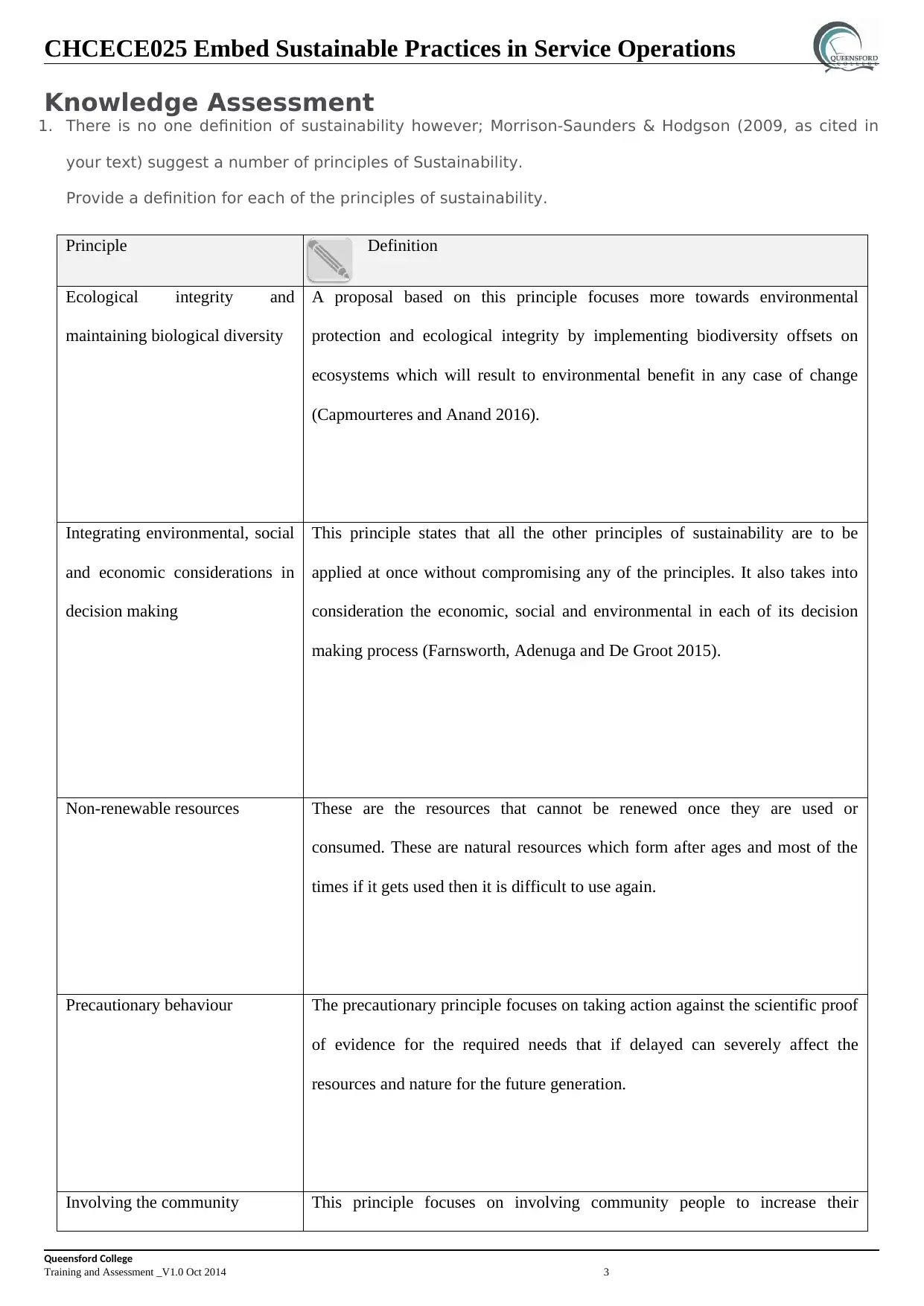
CHCECE025 Embed Sustainable Practices in Service Operations
Knowledge Assessment
1. There is no one definition of sustainability however; Morrison-Saunders & Hodgson (2009, as cited in
your text) suggest a number of principles of Sustainability.
Provide a definition for each of the principles of sustainability.
Principle Definition
Ecological integrity and
maintaining biological diversity
A proposal based on this principle focuses more towards environmental
protection and ecological integrity by implementing biodiversity offsets on
ecosystems which will result to environmental benefit in any case of change
(Capmourteres and Anand 2016).
Integrating environmental, social
and economic considerations in
decision making
This principle states that all the other principles of sustainability are to be
applied at once without compromising any of the principles. It also takes into
consideration the economic, social and environmental in each of its decision
making process (Farnsworth, Adenuga and De Groot 2015).
Non-renewable resources These are the resources that cannot be renewed once they are used or
consumed. These are natural resources which form after ages and most of the
times if it gets used then it is difficult to use again.
Precautionary behaviour The precautionary principle focuses on taking action against the scientific proof
of evidence for the required needs that if delayed can severely affect the
resources and nature for the future generation.
Involving the community This principle focuses on involving community people to increase their
Queensford College
Training and Assessment _V1.0 Oct 2014 3
Knowledge Assessment
1. There is no one definition of sustainability however; Morrison-Saunders & Hodgson (2009, as cited in
your text) suggest a number of principles of Sustainability.
Provide a definition for each of the principles of sustainability.
Principle Definition
Ecological integrity and
maintaining biological diversity
A proposal based on this principle focuses more towards environmental
protection and ecological integrity by implementing biodiversity offsets on
ecosystems which will result to environmental benefit in any case of change
(Capmourteres and Anand 2016).
Integrating environmental, social
and economic considerations in
decision making
This principle states that all the other principles of sustainability are to be
applied at once without compromising any of the principles. It also takes into
consideration the economic, social and environmental in each of its decision
making process (Farnsworth, Adenuga and De Groot 2015).
Non-renewable resources These are the resources that cannot be renewed once they are used or
consumed. These are natural resources which form after ages and most of the
times if it gets used then it is difficult to use again.
Precautionary behaviour The precautionary principle focuses on taking action against the scientific proof
of evidence for the required needs that if delayed can severely affect the
resources and nature for the future generation.
Involving the community This principle focuses on involving community people to increase their
Queensford College
Training and Assessment _V1.0 Oct 2014 3
⊘ This is a preview!⊘
Do you want full access?
Subscribe today to unlock all pages.

Trusted by 1+ million students worldwide
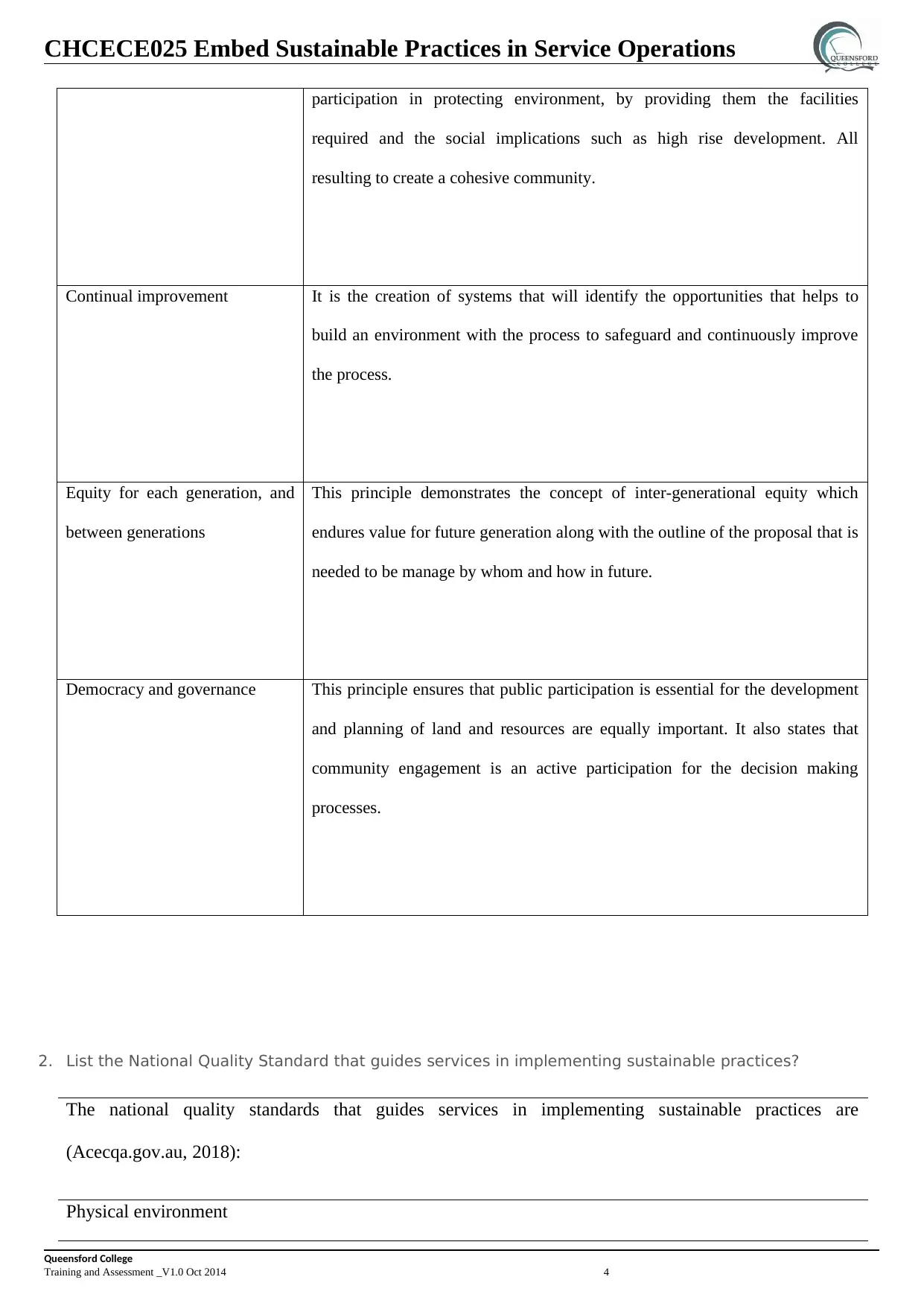
CHCECE025 Embed Sustainable Practices in Service Operations
participation in protecting environment, by providing them the facilities
required and the social implications such as high rise development. All
resulting to create a cohesive community.
Continual improvement It is the creation of systems that will identify the opportunities that helps to
build an environment with the process to safeguard and continuously improve
the process.
Equity for each generation, and
between generations
This principle demonstrates the concept of inter-generational equity which
endures value for future generation along with the outline of the proposal that is
needed to be manage by whom and how in future.
Democracy and governance This principle ensures that public participation is essential for the development
and planning of land and resources are equally important. It also states that
community engagement is an active participation for the decision making
processes.
2. List the National Quality Standard that guides services in implementing sustainable practices?
The national quality standards that guides services in implementing sustainable practices are
(Acecqa.gov.au, 2018):
Physical environment
Queensford College
Training and Assessment _V1.0 Oct 2014 4
participation in protecting environment, by providing them the facilities
required and the social implications such as high rise development. All
resulting to create a cohesive community.
Continual improvement It is the creation of systems that will identify the opportunities that helps to
build an environment with the process to safeguard and continuously improve
the process.
Equity for each generation, and
between generations
This principle demonstrates the concept of inter-generational equity which
endures value for future generation along with the outline of the proposal that is
needed to be manage by whom and how in future.
Democracy and governance This principle ensures that public participation is essential for the development
and planning of land and resources are equally important. It also states that
community engagement is an active participation for the decision making
processes.
2. List the National Quality Standard that guides services in implementing sustainable practices?
The national quality standards that guides services in implementing sustainable practices are
(Acecqa.gov.au, 2018):
Physical environment
Queensford College
Training and Assessment _V1.0 Oct 2014 4
Paraphrase This Document
Need a fresh take? Get an instant paraphrase of this document with our AI Paraphraser

CHCECE025 Embed Sustainable Practices in Service Operations
Standard 3.1 Design that indicates that the design of the facilities should be appropriate for the same.
Standard 3.2 Use supports that the environment should promote exploration and play based learning.
3. What are the main elements of NQS 3.3?
A sustainable practice is to be embedded in service operations and is promoted in the program every day.
Children will be actively involved towards environmentally responsible and a support will be involved
within the
program and in the broader community (Berendonk et al. 2015)
4. To complete this task you will need to read your text book:
Kearns, K. (2014). The Big Picture: Working in Early Childhood Education and Care Series (3rd ed.). Victoria:
Cengage Learning Australia.
Refer to Chapter 9: Supporting Sustainability
a. List five organisational goals for sustainability
Encouraging awareness of conservation within the organization and in the wider community
Promoting environmental awareness and conservation among the employees of the organisation.
Minimizing avoidable waste and pollution in all its form.
Developing waste management and recycling systems and using sustainable resources.
Reducing the use of non-renewable energy
Queensford College
Training and Assessment _V1.0 Oct 2014 5
Standard 3.1 Design that indicates that the design of the facilities should be appropriate for the same.
Standard 3.2 Use supports that the environment should promote exploration and play based learning.
3. What are the main elements of NQS 3.3?
A sustainable practice is to be embedded in service operations and is promoted in the program every day.
Children will be actively involved towards environmentally responsible and a support will be involved
within the
program and in the broader community (Berendonk et al. 2015)
4. To complete this task you will need to read your text book:
Kearns, K. (2014). The Big Picture: Working in Early Childhood Education and Care Series (3rd ed.). Victoria:
Cengage Learning Australia.
Refer to Chapter 9: Supporting Sustainability
a. List five organisational goals for sustainability
Encouraging awareness of conservation within the organization and in the wider community
Promoting environmental awareness and conservation among the employees of the organisation.
Minimizing avoidable waste and pollution in all its form.
Developing waste management and recycling systems and using sustainable resources.
Reducing the use of non-renewable energy
Queensford College
Training and Assessment _V1.0 Oct 2014 5
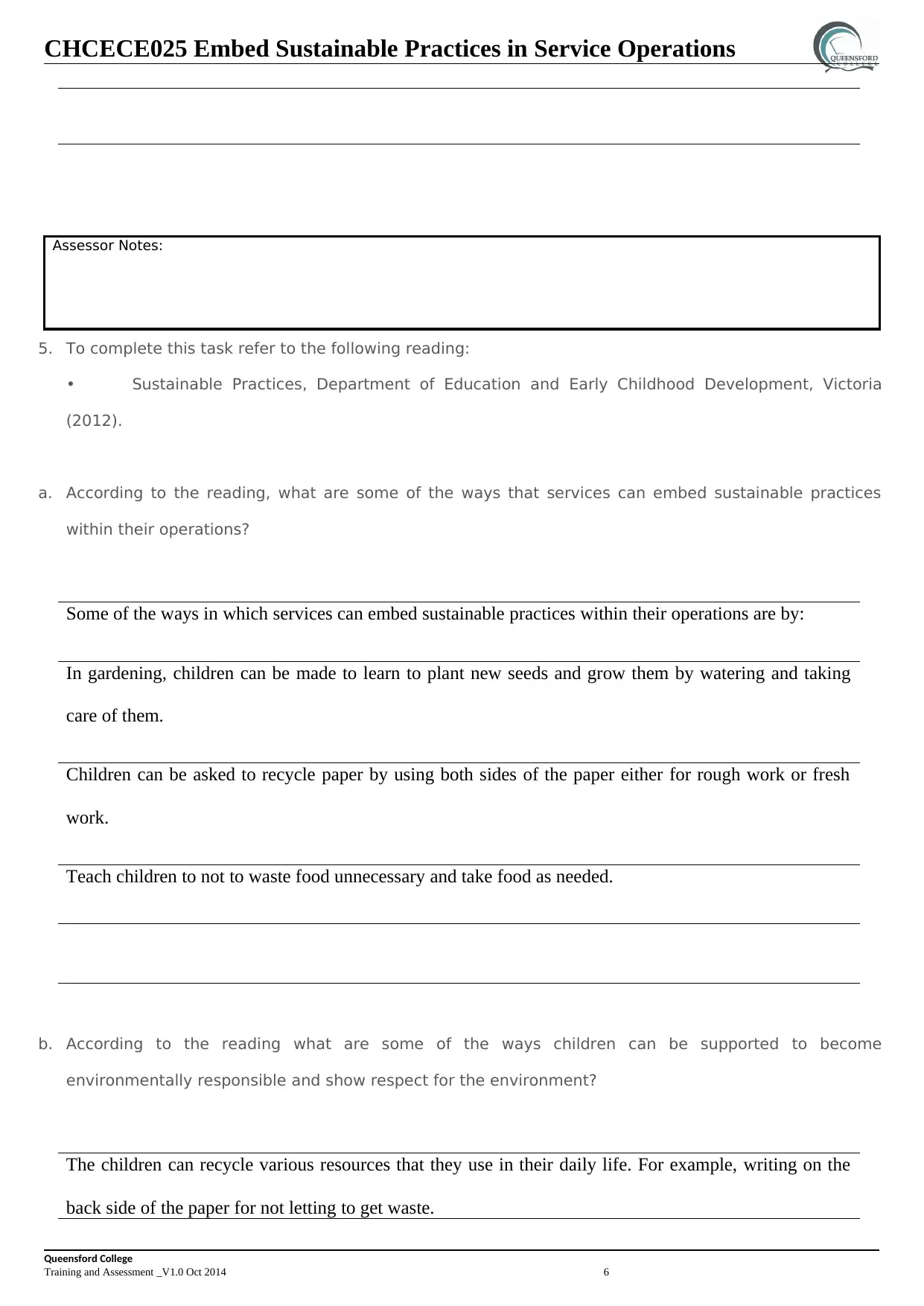
CHCECE025 Embed Sustainable Practices in Service Operations
Assessor Notes:
5. To complete this task refer to the following reading:
• Sustainable Practices, Department of Education and Early Childhood Development, Victoria
(2012).
a. According to the reading, what are some of the ways that services can embed sustainable practices
within their operations?
Some of the ways in which services can embed sustainable practices within their operations are by:
In gardening, children can be made to learn to plant new seeds and grow them by watering and taking
care of them.
Children can be asked to recycle paper by using both sides of the paper either for rough work or fresh
work.
Teach children to not to waste food unnecessary and take food as needed.
b. According to the reading what are some of the ways children can be supported to become
environmentally responsible and show respect for the environment?
The children can recycle various resources that they use in their daily life. For example, writing on the
back side of the paper for not letting to get waste.
Queensford College
Training and Assessment _V1.0 Oct 2014 6
Assessor Notes:
5. To complete this task refer to the following reading:
• Sustainable Practices, Department of Education and Early Childhood Development, Victoria
(2012).
a. According to the reading, what are some of the ways that services can embed sustainable practices
within their operations?
Some of the ways in which services can embed sustainable practices within their operations are by:
In gardening, children can be made to learn to plant new seeds and grow them by watering and taking
care of them.
Children can be asked to recycle paper by using both sides of the paper either for rough work or fresh
work.
Teach children to not to waste food unnecessary and take food as needed.
b. According to the reading what are some of the ways children can be supported to become
environmentally responsible and show respect for the environment?
The children can recycle various resources that they use in their daily life. For example, writing on the
back side of the paper for not letting to get waste.
Queensford College
Training and Assessment _V1.0 Oct 2014 6
⊘ This is a preview!⊘
Do you want full access?
Subscribe today to unlock all pages.

Trusted by 1+ million students worldwide

CHCECE025 Embed Sustainable Practices in Service Operations
Gardening and growing plants nearby to promote healthy and green environment.
Water conservation is another way they can save water and get to know the importance of water in
world.
By saving electricity they can understand the need of the resources.
6. Provide an example of sustainable practices that may be implemented within each of the following
areas within a children’s service.
Service Practice Example
Administrative practices Using the colour and crayons till it can be used. For example, children can use
the colour pencils and crayons till the end of it. Simply, use these items until
they are totally finished.
Use of utilities Children can use air conditioners and electronics when required. For example,
switching on air conditioners each time when entering the room is not required
instead when the time he is going to sleep can on the air condition.
Purchasing Students can limit to purchase of bags and handbags instead first try to use the
one which already exists. This way he can prevent over purchasing and
appropriately use the stuffs.
Use of recycled materials The children can purchase fewer amounts of craft materials instead try to use
Queensford College
Training and Assessment _V1.0 Oct 2014 7
Gardening and growing plants nearby to promote healthy and green environment.
Water conservation is another way they can save water and get to know the importance of water in
world.
By saving electricity they can understand the need of the resources.
6. Provide an example of sustainable practices that may be implemented within each of the following
areas within a children’s service.
Service Practice Example
Administrative practices Using the colour and crayons till it can be used. For example, children can use
the colour pencils and crayons till the end of it. Simply, use these items until
they are totally finished.
Use of utilities Children can use air conditioners and electronics when required. For example,
switching on air conditioners each time when entering the room is not required
instead when the time he is going to sleep can on the air condition.
Purchasing Students can limit to purchase of bags and handbags instead first try to use the
one which already exists. This way he can prevent over purchasing and
appropriately use the stuffs.
Use of recycled materials The children can purchase fewer amounts of craft materials instead try to use
Queensford College
Training and Assessment _V1.0 Oct 2014 7
Paraphrase This Document
Need a fresh take? Get an instant paraphrase of this document with our AI Paraphraser
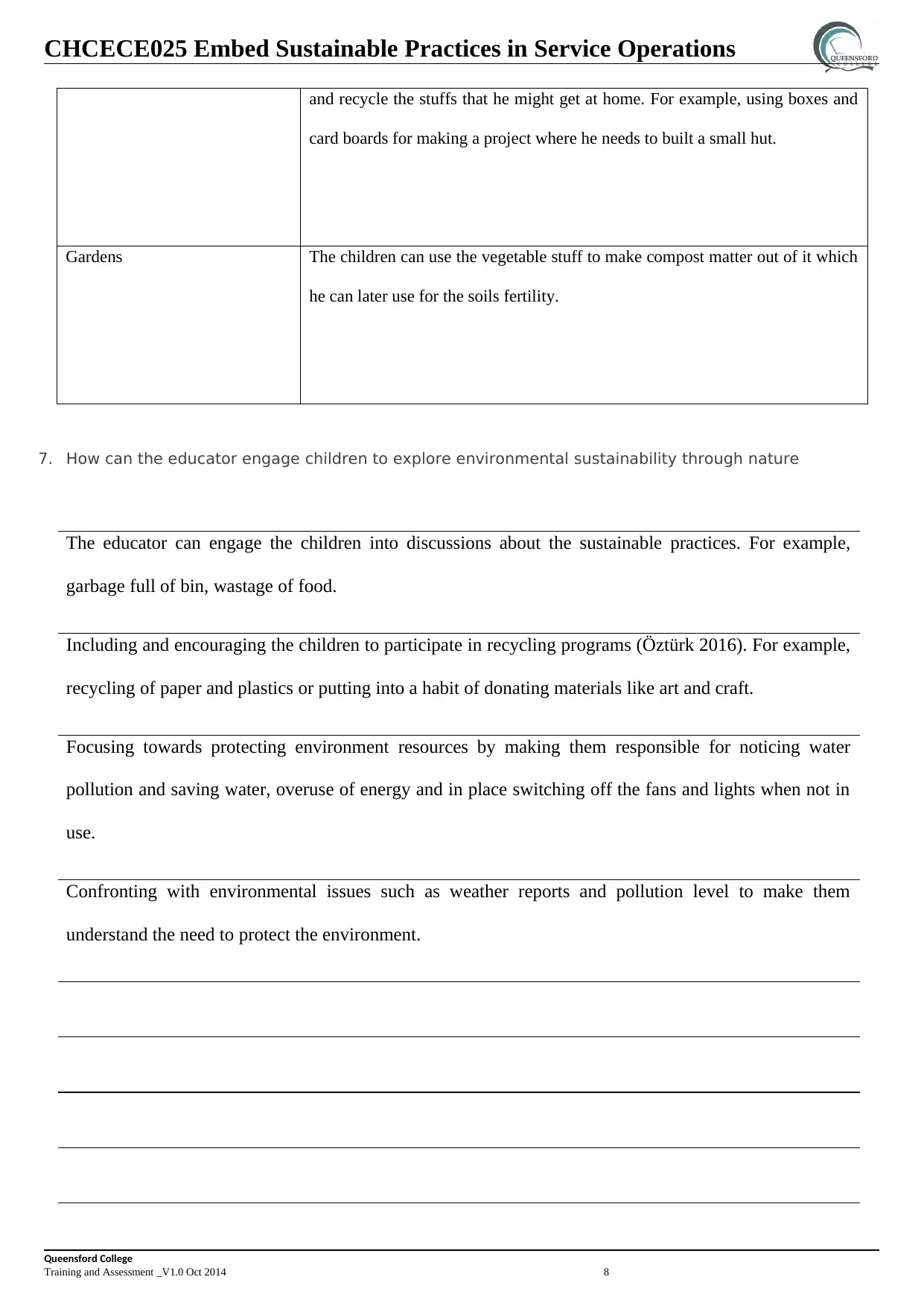
CHCECE025 Embed Sustainable Practices in Service Operations
and recycle the stuffs that he might get at home. For example, using boxes and
card boards for making a project where he needs to built a small hut.
Gardens The children can use the vegetable stuff to make compost matter out of it which
he can later use for the soils fertility.
7. How can the educator engage children to explore environmental sustainability through nature
The educator can engage the children into discussions about the sustainable practices. For example,
garbage full of bin, wastage of food.
Including and encouraging the children to participate in recycling programs (Öztürk 2016). For example,
recycling of paper and plastics or putting into a habit of donating materials like art and craft.
Focusing towards protecting environment resources by making them responsible for noticing water
pollution and saving water, overuse of energy and in place switching off the fans and lights when not in
use.
Confronting with environmental issues such as weather reports and pollution level to make them
understand the need to protect the environment.
Queensford College
Training and Assessment _V1.0 Oct 2014 8
and recycle the stuffs that he might get at home. For example, using boxes and
card boards for making a project where he needs to built a small hut.
Gardens The children can use the vegetable stuff to make compost matter out of it which
he can later use for the soils fertility.
7. How can the educator engage children to explore environmental sustainability through nature
The educator can engage the children into discussions about the sustainable practices. For example,
garbage full of bin, wastage of food.
Including and encouraging the children to participate in recycling programs (Öztürk 2016). For example,
recycling of paper and plastics or putting into a habit of donating materials like art and craft.
Focusing towards protecting environment resources by making them responsible for noticing water
pollution and saving water, overuse of energy and in place switching off the fans and lights when not in
use.
Confronting with environmental issues such as weather reports and pollution level to make them
understand the need to protect the environment.
Queensford College
Training and Assessment _V1.0 Oct 2014 8
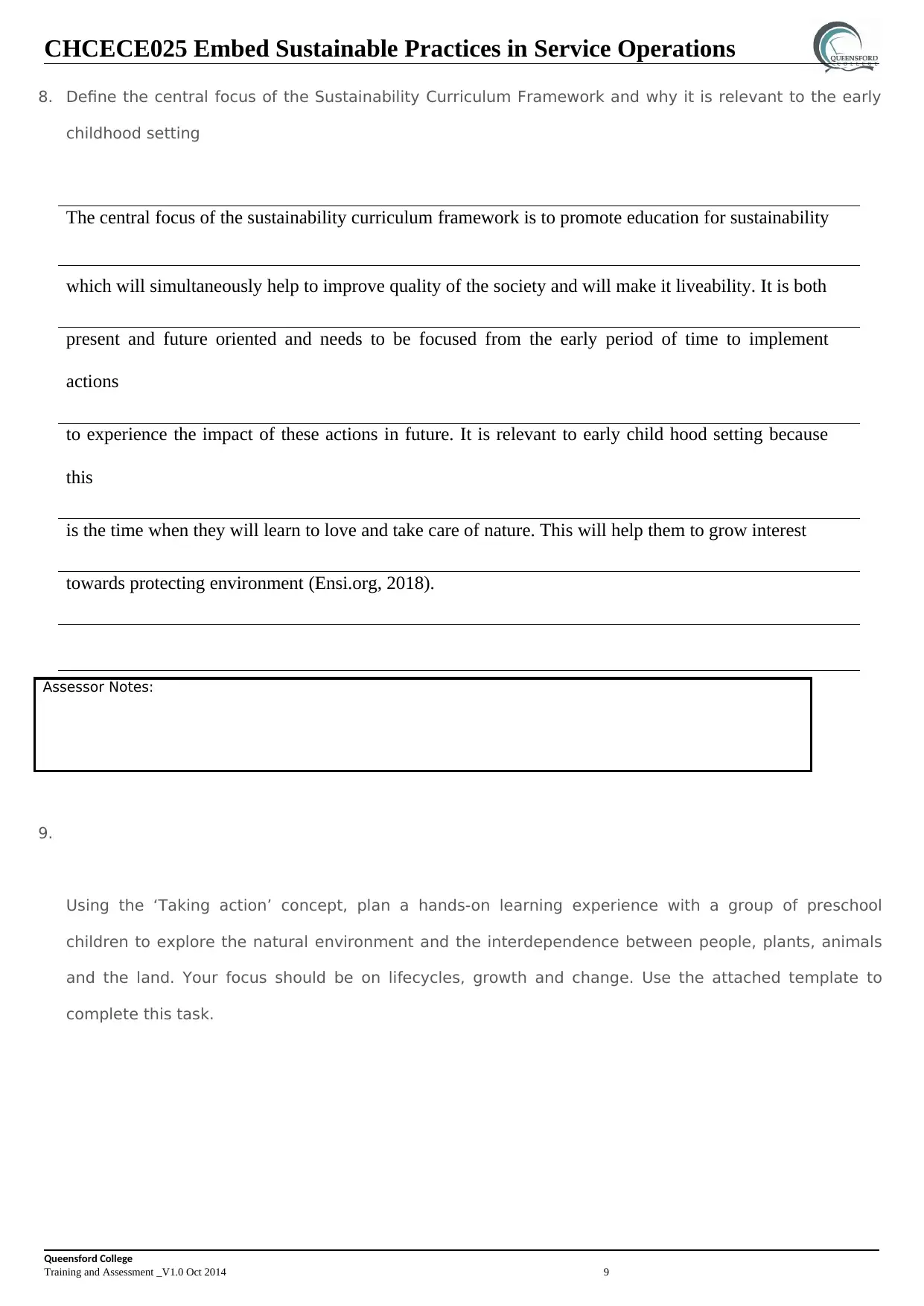
CHCECE025 Embed Sustainable Practices in Service Operations
8. Define the central focus of the Sustainability Curriculum Framework and why it is relevant to the early
childhood setting
The central focus of the sustainability curriculum framework is to promote education for sustainability
which will simultaneously help to improve quality of the society and will make it liveability. It is both
present and future oriented and needs to be focused from the early period of time to implement
actions
to experience the impact of these actions in future. It is relevant to early child hood setting because
this
is the time when they will learn to love and take care of nature. This will help them to grow interest
towards protecting environment (Ensi.org, 2018).
9.
Using the ‘Taking action’ concept, plan a hands-on learning experience with a group of preschool
children to explore the natural environment and the interdependence between people, plants, animals
and the land. Your focus should be on lifecycles, growth and change. Use the attached template to
complete this task.
Queensford College
Training and Assessment _V1.0 Oct 2014 9
Assessor Notes:
8. Define the central focus of the Sustainability Curriculum Framework and why it is relevant to the early
childhood setting
The central focus of the sustainability curriculum framework is to promote education for sustainability
which will simultaneously help to improve quality of the society and will make it liveability. It is both
present and future oriented and needs to be focused from the early period of time to implement
actions
to experience the impact of these actions in future. It is relevant to early child hood setting because
this
is the time when they will learn to love and take care of nature. This will help them to grow interest
towards protecting environment (Ensi.org, 2018).
9.
Using the ‘Taking action’ concept, plan a hands-on learning experience with a group of preschool
children to explore the natural environment and the interdependence between people, plants, animals
and the land. Your focus should be on lifecycles, growth and change. Use the attached template to
complete this task.
Queensford College
Training and Assessment _V1.0 Oct 2014 9
Assessor Notes:
⊘ This is a preview!⊘
Do you want full access?
Subscribe today to unlock all pages.

Trusted by 1+ million students worldwide
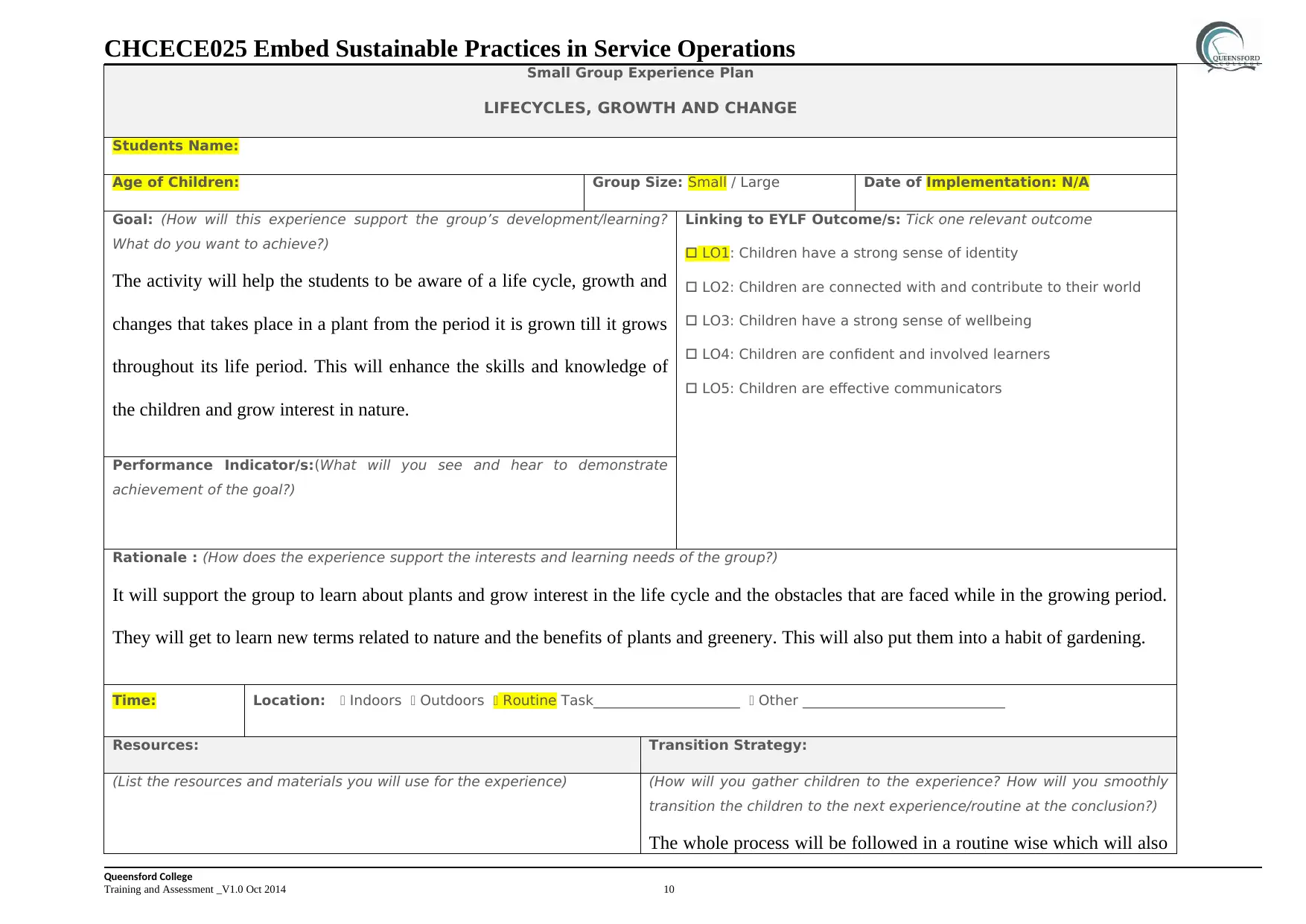
CHCECE025 Embed Sustainable Practices in Service Operations
Small Group Experience Plan
LIFECYCLES, GROWTH AND CHANGE
Students Name:
Age of Children: Group Size: Small / Large Date of Implementation: N/A
Goal: (How will this experience support the group’s development/learning?
What do you want to achieve?)
The activity will help the students to be aware of a life cycle, growth and
changes that takes place in a plant from the period it is grown till it grows
throughout its life period. This will enhance the skills and knowledge of
the children and grow interest in nature.
Linking to EYLF Outcome/s: Tick one relevant outcome
LO1: Children have a strong sense of identity
LO2: Children are connected with and contribute to their world
LO3: Children have a strong sense of wellbeing
LO4: Children are confident and involved learners
LO5: Children are effective communicators
Performance Indicator/s:(What will you see and hear to demonstrate
achievement of the goal?)
Rationale : (How does the experience support the interests and learning needs of the group?)
It will support the group to learn about plants and grow interest in the life cycle and the obstacles that are faced while in the growing period.
They will get to learn new terms related to nature and the benefits of plants and greenery. This will also put them into a habit of gardening.
Time: Location: Indoors Outdoors Routine Task_____________________ Other _____________________________
Resources: Transition Strategy:
(List the resources and materials you will use for the experience) (How will you gather children to the experience? How will you smoothly
transition the children to the next experience/routine at the conclusion?)
The whole process will be followed in a routine wise which will also
Queensford College
Training and Assessment _V1.0 Oct 2014 10
Small Group Experience Plan
LIFECYCLES, GROWTH AND CHANGE
Students Name:
Age of Children: Group Size: Small / Large Date of Implementation: N/A
Goal: (How will this experience support the group’s development/learning?
What do you want to achieve?)
The activity will help the students to be aware of a life cycle, growth and
changes that takes place in a plant from the period it is grown till it grows
throughout its life period. This will enhance the skills and knowledge of
the children and grow interest in nature.
Linking to EYLF Outcome/s: Tick one relevant outcome
LO1: Children have a strong sense of identity
LO2: Children are connected with and contribute to their world
LO3: Children have a strong sense of wellbeing
LO4: Children are confident and involved learners
LO5: Children are effective communicators
Performance Indicator/s:(What will you see and hear to demonstrate
achievement of the goal?)
Rationale : (How does the experience support the interests and learning needs of the group?)
It will support the group to learn about plants and grow interest in the life cycle and the obstacles that are faced while in the growing period.
They will get to learn new terms related to nature and the benefits of plants and greenery. This will also put them into a habit of gardening.
Time: Location: Indoors Outdoors Routine Task_____________________ Other _____________________________
Resources: Transition Strategy:
(List the resources and materials you will use for the experience) (How will you gather children to the experience? How will you smoothly
transition the children to the next experience/routine at the conclusion?)
The whole process will be followed in a routine wise which will also
Queensford College
Training and Assessment _V1.0 Oct 2014 10
Paraphrase This Document
Need a fresh take? Get an instant paraphrase of this document with our AI Paraphraser
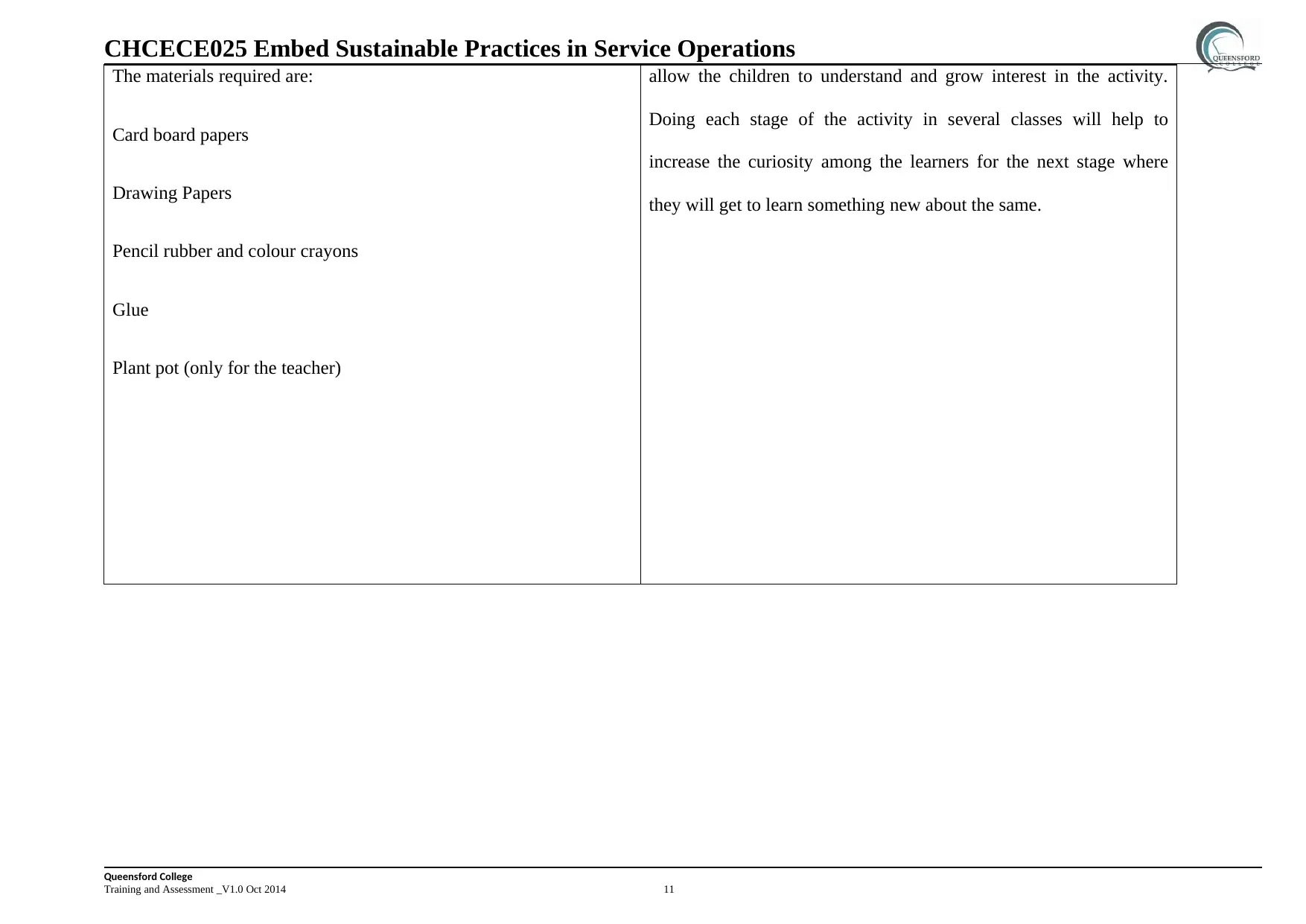
CHCECE025 Embed Sustainable Practices in Service Operations
The materials required are:
Card board papers
Drawing Papers
Pencil rubber and colour crayons
Glue
Plant pot (only for the teacher)
allow the children to understand and grow interest in the activity.
Doing each stage of the activity in several classes will help to
increase the curiosity among the learners for the next stage where
they will get to learn something new about the same.
Queensford College
Training and Assessment _V1.0 Oct 2014 11
The materials required are:
Card board papers
Drawing Papers
Pencil rubber and colour crayons
Glue
Plant pot (only for the teacher)
allow the children to understand and grow interest in the activity.
Doing each stage of the activity in several classes will help to
increase the curiosity among the learners for the next stage where
they will get to learn something new about the same.
Queensford College
Training and Assessment _V1.0 Oct 2014 11
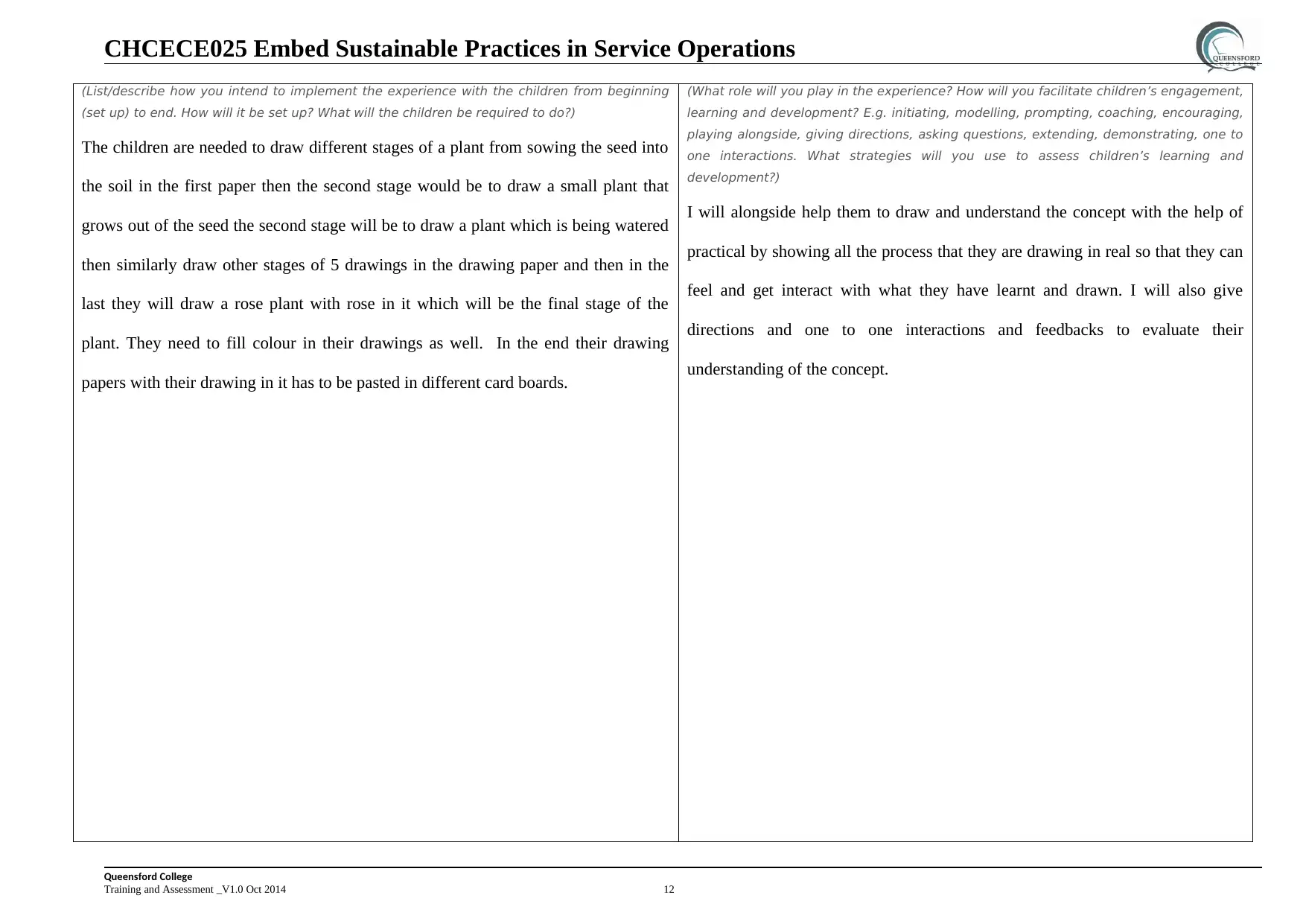
CHCECE025 Embed Sustainable Practices in Service Operations
(List/describe how you intend to implement the experience with the children from beginning
(set up) to end. How will it be set up? What will the children be required to do?)
The children are needed to draw different stages of a plant from sowing the seed into
the soil in the first paper then the second stage would be to draw a small plant that
grows out of the seed the second stage will be to draw a plant which is being watered
then similarly draw other stages of 5 drawings in the drawing paper and then in the
last they will draw a rose plant with rose in it which will be the final stage of the
plant. They need to fill colour in their drawings as well. In the end their drawing
papers with their drawing in it has to be pasted in different card boards.
(What role will you play in the experience? How will you facilitate children’s engagement,
learning and development? E.g. initiating, modelling, prompting, coaching, encouraging,
playing alongside, giving directions, asking questions, extending, demonstrating, one to
one interactions. What strategies will you use to assess children’s learning and
development?)
I will alongside help them to draw and understand the concept with the help of
practical by showing all the process that they are drawing in real so that they can
feel and get interact with what they have learnt and drawn. I will also give
directions and one to one interactions and feedbacks to evaluate their
understanding of the concept.
Queensford College
Training and Assessment _V1.0 Oct 2014 12
(List/describe how you intend to implement the experience with the children from beginning
(set up) to end. How will it be set up? What will the children be required to do?)
The children are needed to draw different stages of a plant from sowing the seed into
the soil in the first paper then the second stage would be to draw a small plant that
grows out of the seed the second stage will be to draw a plant which is being watered
then similarly draw other stages of 5 drawings in the drawing paper and then in the
last they will draw a rose plant with rose in it which will be the final stage of the
plant. They need to fill colour in their drawings as well. In the end their drawing
papers with their drawing in it has to be pasted in different card boards.
(What role will you play in the experience? How will you facilitate children’s engagement,
learning and development? E.g. initiating, modelling, prompting, coaching, encouraging,
playing alongside, giving directions, asking questions, extending, demonstrating, one to
one interactions. What strategies will you use to assess children’s learning and
development?)
I will alongside help them to draw and understand the concept with the help of
practical by showing all the process that they are drawing in real so that they can
feel and get interact with what they have learnt and drawn. I will also give
directions and one to one interactions and feedbacks to evaluate their
understanding of the concept.
Queensford College
Training and Assessment _V1.0 Oct 2014 12
⊘ This is a preview!⊘
Do you want full access?
Subscribe today to unlock all pages.

Trusted by 1+ million students worldwide
1 out of 20
Related Documents
Your All-in-One AI-Powered Toolkit for Academic Success.
+13062052269
info@desklib.com
Available 24*7 on WhatsApp / Email
![[object Object]](/_next/static/media/star-bottom.7253800d.svg)
Unlock your academic potential
Copyright © 2020–2025 A2Z Services. All Rights Reserved. Developed and managed by ZUCOL.





